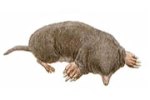Control Your Mole In Minnesota Part 2
Moles are not rodents. They belong to the group of mammals known as insectivores, and thus are related to the shrew. Eastern moles have pointed snouts, greatly enlarged, rounded front feet with stout claws, and a short, nearly naked tail. They are six to eight inches long with short, velvety fur that is usually gray to silvery-gray. The eyes and ears of moles are very small and are concealed in the fur.
Moles can be destructive pests in lawns, gardens, nurseries, parks, golf courses, and cemeteries. During their burrowing activities, they produce mounds and ridges that disfigure lawns and sometimes dislodge plants or injure plant roots. Their mounds also provide a medium for the germination of weed seeds.
Moles feed primarily on earthworms, beetle grubs, ants, and other animals which live in the soil. A smaller part of their diet consists of various seed and vegetable matter. They usually do not eat bulbs or the roots of garden plants. Several species of mice also use mole runways; often these are the culprits responsible for the occasional damage to roots and tubers in flower and vegetable gardens.
Moles are active day and night throughout the year, but they are most active near the earth’s surface during the spring and fall on damp days or following rain showers. When the ground surface becomes frozen in the winter, or very dry during the summer, moles use only the deeper burrows. Daily peak activity periods are during the morning hours, although moles may be seen working off and on throughout the day and night.
Mating occurs during February and March, with a single litter of three to five young born later in the spring following a six-week gestation period. Young moles grow rapidly and leave the nest to fend for themselves at about one month of age. If you have seen indentations in your lawn, or small mounds and are not sure what they are, it is time to call your Minnesota Wild Animal Management representative.
Biology and Behavior
|
Adult weight: |
|
|
Total length: |
6-8 inches. |
|
Color: |
Gray to silvery-gray. |
|
Gestation: |
42 days. |
|
Litter size: |
3-5. |
|
Life span: |
3 years. |
Control Your Mole In Minnesota Part 2
Moles are not rodents. They belong to the group of mammals known as insectivores, and thus are related to the shrew. Eastern moles have pointed snouts, greatly enlarged, rounded front feet with stout claws, and a short, nearly naked tail. They are six to eight inches long with short, velvety fur that is usually gray to silvery-gray. The eyes and ears of moles are very small and are concealed in the fur.
Moles can be destructive pests in lawns, gardens, nurseries, parks, golf courses, and cemeteries. During their burrowing activities, they produce mounds and ridges that disfigure lawns and sometimes dislodge plants or injure plant roots. Their mounds also provide a medium for the germination of weed seeds.
Moles feed primarily on earthworms, beetle grubs, ants, and other animals which live in the soil. A smaller part of their diet consists of various seed and vegetable matter. They usually do not eat bulbs or the roots of garden plants. Several species of mice also use mole runways; often these are the culprits responsible for the occasional damage to roots and tubers in flower and vegetable gardens.
Moles are active day and night throughout the year, but they are most active near the earth’s surface during the spring and fall on damp days or following rain showers. When the ground surface becomes frozen in the winter, or very dry during the summer, moles use only the deeper burrows. Daily peak activity periods are during the morning hours, although moles may be seen working off and on throughout the day and night.
Mating occurs during February and March, with a single litter of three to five young born later in the spring following a six-week gestation period. Young moles grow rapidly and leave the nest to fend for themselves at about one month of age.
Biology and Behavior
|
Adult weight: |
3-4 ounces. |
|
Total length: |
6-8 inches. |
|
Color: |
Gray to silvery-gray. |
|
Gestation: |
42 days. |
|
Litter size: |
3-5. |
|
Life span: |
3 years. |




